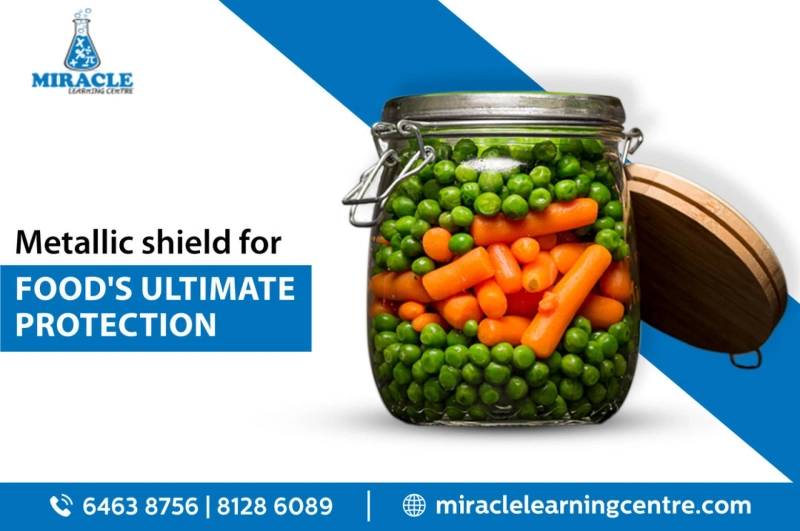When we go grocery shopping, we often overlook the importance of food packaging. Yet, it plays a vital role in preserving the quality, safety, and freshness of the products we consume. Metal stands out as a reliable and secure alternative among the numerous materials used for food packaging. Because of its unique characteristics, it is an ideal alternative for guaranteeing the integrity of packaged food. In this blog, we will look at the importance of metal in food packaging and why it is such a reliable material.
So, grab a seat and join us on this enlightening journey brought to you by Chemistry Tuition of Miracle Learning Centre.
Why is food packaging required?
Food packaging is a necessary component for various reasons. It acts as a protective barrier, shielding the food from contamination, light exposure, and air contact that could compromise its safety and quality. Packaging also plays an important role in prolonging the shelf life of products, reducing food waste, and minimizing the risk of spoilage. It provides consumers with essential information, including nutritional details, ingredient lists, and expiration dates, enabling them to make informed decisions. Food packaging facilitates convenient transportation and storage, ensuring that products maintain their freshness and reach consumers in optimal condition throughout the supply chain.
Why Packaging Food with Metal is Safe?
Metal packaging is the key to preserving the freshness and integrity of various food products. It offers several benefits that contribute to its safety and effectiveness.
Metal is a non-permeable material, which means it acts as a barrier against oxygen, light, moisture, and other external factors that can deteriorate food quality. This feature helps to maintain the taste, texture, and nutritional value of the packaged food.
Metal packaging is resistant to extreme temperatures, making it suitable for a wide range of food items. Whether it is canned vegetables, beverages, or even pet food, metal containers can withstand heat during processing and sterilization without compromising the safety of the contents. This durability ensures that the food remains uncontaminated throughout its journey from production to consumption.
Another reason why packaging food with metal is safe is the material\'s hygienic properties. Metal surfaces are easy to clean and sanitize, reducing the risk of bacterial growth and cross-contamination. This is particularly important when it comes to perishable or sensitive food products, such as dairy, seafood, or baby food. Metal packaging helps to maintain the product\'s hygiene and prevents the spread of food borne illnesses.
Stay tuned for the next sections, where we will delve deeper into the chemistry behind metal\'s suitability for food packaging. If you\'re interested in learning more about chemistry and expanding your knowledge, be sure to check out Chemistry Tuition at Miracle Learning Centre in Singapore.
Learn about several food-safe metals:
Aluminum:
Aluminum is widely used in beverage cans, food containers, and foil wraps. It is lightweight, corrosion-resistant, and easily recyclable. Aluminium cans provide an excellent barrier against light and oxygen, ensuring the freshness of carbonated drinks and canned food.
Tinplate:
Tinplate, a thin steel sheet coated with a layer of tin, is commonly used in canned food packaging. The tin coating prevents corrosion, while the steel base provides strength and stability. Canned fruits, vegetables, soups, and meats are often packed in tinplate cans, ensuring their safety and prolonged shelf life.
Stainless Steel:
Stainless steel is a durable and hygienic material used for various food packaging applications. It is commonly seen in food containers, utensils, and kitchen appliances. Stainless steel does not react with food and is resistant to corrosion, making it a safe choice for both dry and liquid food products.
Conclusion:
In conclusion, the role of metal in food packaging cannot be overstated. Its safety, versatility, and durability make it an indispensable material for preserving and protecting our food. The hygienic properties of metal packaging also help prevent bacterial growth and cross-contamination, safeguarding our health. As we rely on metal packaging for our food needs, it is important to recognize the chemistry behind its effectiveness and the significant contribution it makes to the food industry.
If you want to learn more about the chemistry behind food packaging or any other scientific topic, consider enrolling in Chemistry Tuition. In Singapore, when searching for the best chemitry tuition centre for your child, Miracle Learning Centre emerges as a top choice. They offer comprehensive courses and experienced tutors who can guide you through the fascinating world of chemistry.


